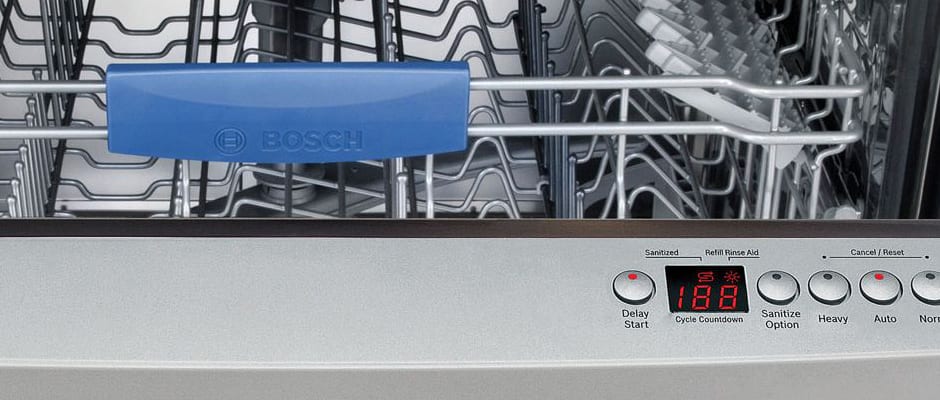Pros
Cons
Introduction
Design & Usability
{{section_header}}{{section.name}}{{/section_header}}
Top-mounted controls, but there's still an ugly plastic cover on the exterior.
We don't know what Bosch's design team was thinking. They put the controls on top of the door, which is usually done to free up the front of the machine from buttons and lights so it can appear as a monolithic chunk of stainless steel. However, instead of a stainless handle, the designers added a cheap-looking gray plastic cover. It's visually unappealing and definitely user-unfriendly.
Inside, there's at least a stainless interior that acts as a drying aid and sound barrier, with room for ten place settings. If the upper rack is not required, the rack and wash arm can be removed and replaced with a sprayer, which is useful for washing large objects such as oven trays or cookie sheets. At the bottom, there are three filters that capture food particulates. There is no way to separate them before removing them, which makes cleaning them a little awkward if food gets caught between two layers of filter.
{{photo_gallery "Front Closed Photo", "Fingerprints Photo", "Controls 1 Photo", "Controls 2 Photo", "Front Open Photo", "Interior Detail Photo", "Top Rack Photo", "Top Rack Detail Photo 1", "Top Rack Detail Photo 2", "Top Rack Detail Photo 3", "Bottom Rack Photo", "Bottom Rack Detail Photo 2", "Bottom Rack Detail Photo 3", "Cutlery Basket Photo", "Cutlery Basket Detail Photo 1", "Cutlery Basket Detail Photo 2", "Cutlery Basket Detail Photo 3"}}
Features
{{section_header}}{{section.name}}{{/section_header}}
A good selection of wash cycles with no ability to customize them.
There are five cycles on offer from this washer, ranging from the long heavy duty wash to a very speedy 30-minute wash. Absent is a Quick cycle and a China/Glassware cycle. There are no customization options on offer: you cannot change the intensity of the wash or tweak the temperature. In fact, there are just two options for adding additional steps to the wash: a wash delay that goes for up to 12 hours and a sanitize option that adds a high-temperature rinse.
Performance
{{section_header}}{{section.name}}{{/section_header}}
All cycles take over two hours and lack cleaning power.
In our tests, the Bosch Evolution was far too gentle, leaving behind and redistributing dirt throughout the interior and across otherwise clean dishes. It's incredibly frustrating to open a "clean" dishwasher and find that nearly every plate has some food soil left on it, but that's what happened during our testing of this Bosch. Extremely disappointing, indeed, and reason enough to steer clear of this appliance. If you do make the mistake of buying it, you'll likely find that the dishwasher's yearly operating costs are around $37.56. That's a little bit above average, but not extremely inefficient.
Conclusion
{{section_header}}{{section.name}}{{/section_header}}
Don't buy it. Just...don't buy it.
Ugh. The Bosch Evolution SHE55R55UC has no redeeming qualities. The company makes some excellent dishwashers, but this isn't one of them. As we mentioned before, there's absolutely no reason to buy this appliance; we wouldn't recommend it to our worst enemies...if we did, they wouldn't take our other bad recommendations seriously.
Science Introduction
{{section_header}}{{section.name}}{{/section_header}}
All of the dishwashers we test go through the same procedures. In a rare example of how not to design a dishwasher, take a look at our data to see just how far back down the evolutionary chain of appliances this Bosch went.
Performance
{{section_header}}{{section.name}}{{/section_header}}
Unacceptable wash performance.
The problem with the Bosch wasn't so much that it couldn't clean dishes, but that it got them dirty again in entirely new ways during the cleaning process. After more than two hours, dishes emerged still somewhat soiled. Though it did a good job cleaning off tough stains like lipstick, any debris that washed off ended up on other dishes. In the end, though the original stains had mostly disappeared, more than half the dishes were left with some redistributed muck on them.
Stains were mostly lifted from dishes on the Heavy Duty cycle, but once again debris ended up redistributed across otherwise clean plates. This was especially apparent in the lasagna pan, which was devoid of baked-on cheese but full of soapy wet noodles. The SHE55R55UC has no Quick cycle, only a “Half Load” for dishwashers that are half full (or half empty, depending on your outlook).
{{photo_gallery "Science Section 1 Images"}}
Efficiency
{{section_header}}{{section.name}}{{/section_header}}
Slightly below-average efficiency.
Since there’s no Quick cycle, we had to adjust our efficiency tests. Accordingly, we assumed that the Normal load would replace the Quick cycle for most users. As with most dishwashers, about 80 percent of the Bosch Evolution SHE55R55UC’s electricity cost per cycle is due to electricity needed for heating water and drying dishes. The Normal cycle uses only 4.9 gallons of water and costs 17 cents per wash to run, though the Heavy Duty cycle uses 7.35 gallons and costs 21 cents per wash to run.
{{photo_gallery "Science Section 2 Images"}}
Capacity
{{section_header}}{{section.name}}{{/section_header}}
{{photo_gallery "Other Tests Images"}}
Meet the tester
Richard Baguley is a veteran writer who has written about technology ranging from Alphabet to Zip file utilities. He has contributed to pretty much every major tech publication, including Amiga Format Magazine, PC World, Wired, CNET, Toms Guide, Forbes, and many others. He lives in the Boston metro area with his wife, dog, and an indeterminate number of cats.
Checking our work.
Our team is here to help you buy the best stuff and love what you own. Our writers, editors, and experts obsess over the products we cover to make sure you're confident and satisfied. Have a different opinion about something we recommend? Email us and we'll compare notes.
Shoot us an email

